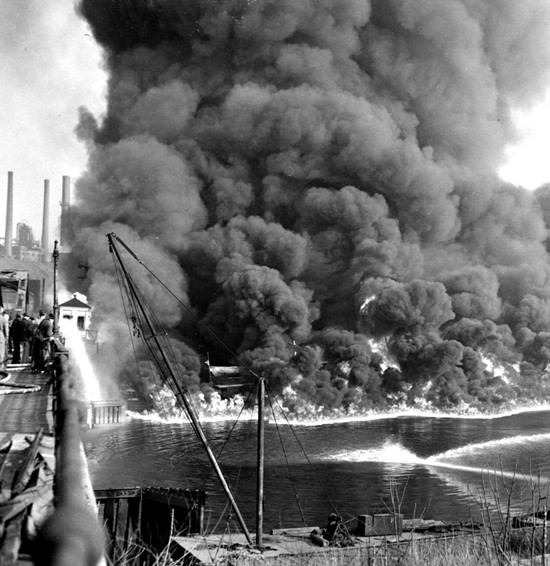The famous Cuyahoga River fire of June 22, 1969 — the spur that started debate on pollution across the nation, and led to passage of the Clean Water Act three years later — is lodged more in legendary storytelling than in reality. The fire was actually fairly minor, causing only $50,000 in losses to the Republic Steel Mill located along the river, damaging some wooden trestles. Moreover, no photograph of the event exists — the photo reproduced here, like the one a month later in Time magazine, was from a much larger 1952 blaze.
 According to Cleveland Historical, the river actually caught fire several times before the 1969 event went viral. So concern was not new. In fact, in 1881, “the mayor of Cleveland had called the Cuyahoga ‘an open sewer through the center of the city,’” as quoted in Teresa Opheim’s excellent write-up in EPA Journal on the event’s 20th anniversary. The river picked up effluvia from Akron to Cleveland and dumped it into Lake Erie, creating a cesspool.
According to Cleveland Historical, the river actually caught fire several times before the 1969 event went viral. So concern was not new. In fact, in 1881, “the mayor of Cleveland had called the Cuyahoga ‘an open sewer through the center of the city,’” as quoted in Teresa Opheim’s excellent write-up in EPA Journal on the event’s 20th anniversary. The river picked up effluvia from Akron to Cleveland and dumped it into Lake Erie, creating a cesspool.
In Opheim’s account, the “spiritual damage” reported by local newspapers was far greater than the actual damage when the river, covered with oil and debris, ignited for 20 minutes that summer day. Cleveland soon became a national punch line. Its fabled industry, the economic underpinning of the region, kept visitors away from the city and kept the locals surrounded by water pollution, not to mention foul air.
Ironically, according to Cleveland Historical’s Michael Rotman, “the city and its residents were beginning to take responsibility for the cleanliness of the river” in the decade preceding the famous fire. In fact, “residents overwhelmingly passed a $100 million bond initiative to fund the Cuyahoga’s cleanup” a year before the blaze. And in an extended blog post titled “Fables of the Cuyahoga: Reconstructing a History of Environmental Protection,” Case-Western law professor Jonathan Adler lists numerous actions in response to the stream’s pollution taken prior to the fire.
Adler would presumably agree with Rotman’s conclusion that the 1969 conflagration “was not really the terrifying climax of decades of pollution, but rather the last gasp of an industrial river whose role was beginning to change.”
Today, burning pollutants on an urban river would bring up issues of environmental justice, so it is worth noting that the fire is a good example of the impacts often faced by poor and/or minority communities. The blaze took place just yards from the city’s first African American neighborhood. Into the breach stepped Carl Stokes, the dynamic mayor and the man responsible for the river cleanup bond campaign a year previously.
Stokes was the first black elected to head a major American city. As a result, “the national press had their reporters here 24 hours a day,” resident Ben Stefanski would later observe. “They were living here so they had to tell the story” when the infamous fire broke out.
As Rotman reports, Mayor Stokes “became deeply involved with the issue, holding a press conference at the site of the fire the following day and testifying before Congress — including his brother U.S. Representative Louis Stokes — to urge greater federal involvement in pollution control.” The mayor demanded funding from Washington as well as changes in the law to stop allowing facilities to discharge into the Cuyahoga with impunity. “The Stokes brothers’ advocacy played a part in the passage of the federal Clean Water Act of 1972,” Rotman concludes.
Though the Stokeses successfully leveraged environmental concern to help a polluted African American neighborhood, the cleanup was slow. Today, the stream’s health, while vastly improved in terms of industrial discharges, is still impaired by non-point sources not easily regulated by the federal law. Thus, although the Cuyahoga was designated an American Heritage River in 1998, the watershed is one of 43 Great Lakes Areas of Concern in EPA’s classification. Cuyahoga Valley National Park was established in 1974, but it begins upriver from the neighborhood where the blaze occurred. That community still includes a dredged working river flanked by a cement plant, gravel pits, abandoned sites, and a steel mill.
[This piece originally appeared in the May – June 2019 issue of The Environmental Forum® and is reprinted with permission]
